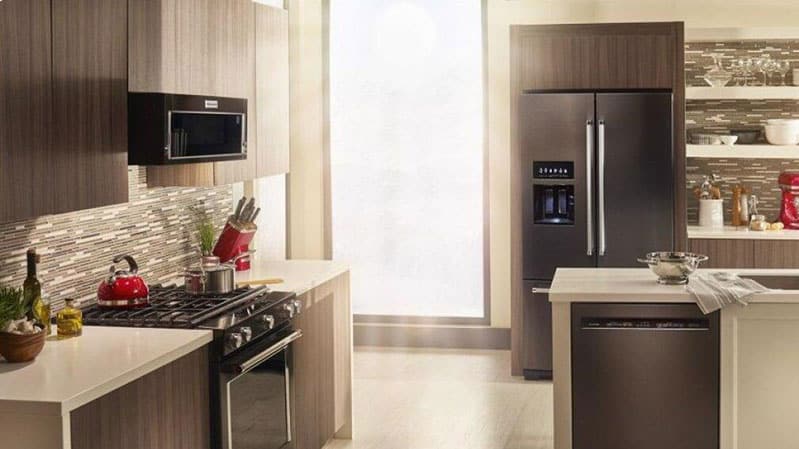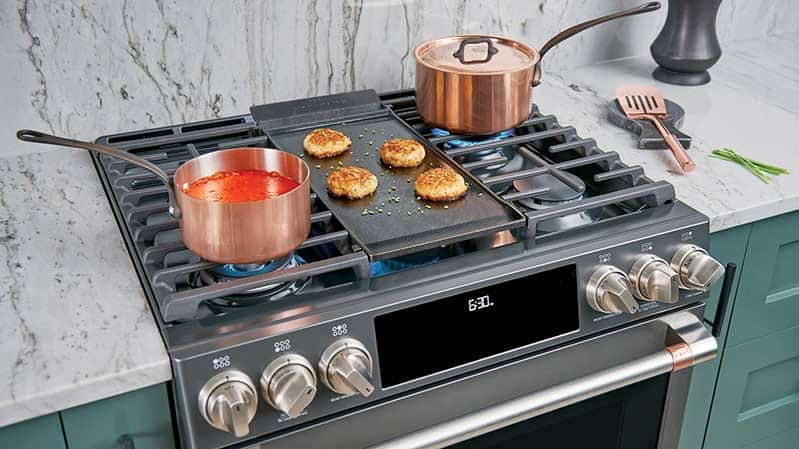🔍 Quick Answer:
Over-the-range microwaves don’t vent well enough for real cooking. Their weak fans, shallow depth, and outdated design can’t keep up with today’s powerful gas burners. If you cook often, invest in a proper hood (600–1,200 CFM, at least 23" deep) to keep your air clean and kitchen healthy.
I had an over-the-range microwave once, back when I lived in a small apartment in Jamaica Plain.
I’d boil water on the front burner and watch the steam drift right past the fan. Cooking salmon was even worse.
That smell stayed in the kitchen for days.
If you cook more than the occasional frozen dinner, putting a microwave over your stove is one of the biggest compromises you can make.
In this guide, you’ll see why it no longer keeps up with modern cooking, and what really happens to all that smoke, grease, and heat when the fan can’t do its job.
Most importantly, I’ll show you better ways Boston homeowners, builders, and designers can keep a kitchen clean, clear, and healthy without regrets later.
📽️Prefer a video rundown? Watch the intro video below. It covers:
- Why over-the-range microwaves can’t keep up with modern cooking
- Today’s burner output (up to 22,000 BTU) and what that means for smoke and grease
- OTR limits: ~16" depth and ~300–400 CFM → weak capture and recirculation
- The result: lingering odors and pollutants staying inside
- What to choose instead: a proper hood 23–24" deep and ≥600 CFM for serious cooking
📌Skip Ahead
Looking for answers about Ventilation?
Short on time? Download our free Ventilation Buying Guide.
What’s the History Behind Over-the-Range Microwaves?

Quick Answer: Over-the-range microwaves first appeared in the late 1980s as a space-saving solution that combined a microwave with a vent.
When they first appeared in the 1980s, they seemed like a smart idea.
They saved counter space, matched your stove, and combined a microwave with a vent. GE started it, and soon every brand had one.
Some added features like convection or special light-based cooking for speed.
But the core design hasn’t changed in forty years.
They still measure about sixteen inches deep.
The fan moves only 300 to 400 cubic feet of air per minute, which is too weak for real cooking. They also vent the same way they always did.
Meanwhile, the stove you’re buying has much greater output.
Thirty years ago, a big gas burner was about 12,000 BTUs. Today, front burners often push 20,000 BTUs or more.
What’s also changed is the price. Now you can buy one for as little as $175 to $399.
That’s why we still see them in so many Boston kitchens. Builders add them to keep costs down and check the ventilation box.
They look fine on paper.
But for anyone who actually cooks, they fall short fast.
How Are Over-the-Range Microwaves Installed?

Quick Answer: Installing an over-the-range microwave is simple, but you’ll need two people. A bracket attaches to the wall studs behind your stove. The microwave slides on and locks into place.
Most use a standard 110-volt outlet. If you’re swapping out a vent hood, you might need an electrician to add a plug instead of a hard-wire.
You can vent the microwave up through the ceiling, straight out the back wall, or use a filter to recirculate air.
Recirculating is better than nothing, but not by much. You’re still blowing heat, odors, and some harmful particles right back into your kitchen.
Why Do People Still Buy Over-the-Range Microwaves?

Quick Answer: They save space, cost less, and look good enough, especially in smaller kitchens.
They still seem like a smart choice for a lot of people. Here’s why:
First, they save counter space. Putting the microwave over the stove frees up your counters and keeps everything in one place. In smaller Boston condos or older homes, every inch matters.
Second, they’re cheap. An over-the-range microwave can cost just $175 to $399. That’s far less than buying a separate hood plus a countertop microwave or drawer.
Third, they look good enough.
If you buy the same brand as your stove, the handles and trim match.
Many builders include them to keep the budget down and check the ventilation box, even if the fan does very little.
On paper, this shortcut makes sense. But if you cook often, especially on a gas range with bigger burners, this “good enough” solution quickly turns into a problem.
What Makes Over-the-Range Microwaves a Bad Choice for People Who Cook?
Quick Answer: They haven’t kept up with modern cooking. Stronger burners, tighter homes, and the same weak fan just don’t mix.
Same Old Design

Over-the-range microwaves have remained largely unchanged since the late 1980s.
Same shallow depth. Same weak blower. Same struggle to keep up with cooking.
Bigger Burners

Your stove has changed a lot.
Thirty years ago, a big gas burner was about 12,000 BTUs.
Today, front burners often push 20,000 to 22,000 BTUs.
More heat means more smoke, grease, and chemicals in the air.
Tighter Homes

Most front burners sit about twenty-three inches from the wall.
A typical over-the-range microwave is only sixteen inches deep.
That gap lets steam and smoke blow right past the fan.
New, more efficient windows and better insulation trap that air inside.
What’s the Best Way to Vent Your Kitchen Properly?

Quick Answer:
✅ Use the right blower power: 600–1,200 CFM for gas ranges
✅ Choose a deep hood: At least 23" to cover front burners
✅ Plan the duct run: Keep it short, straight, and 6–10" wide
Good kitchen ventilation doesn’t have to be complicated.
Check the Blower Power

Start with the blower power. This is measured in CFM, which stands for cubic feet per minute—how much air the fan can move.
A typical over-the-range microwave moves about 300 to 400 CFM. A real hood for a bigger gas range should be closer to 600 to 1,200 CFM.
Keep in mind, anything over 400 CFM in Massachusetts usually needs make-up air. This means adding fresh air back in so your house doesn’t pull cold drafts through gaps.
Look at the Capture Area
Next, check the capture area. This refers to the depth of the hood over your stove.
Most range hoods are 21 to 24 inches deep. An over-the-range microwave is only about sixteen.

You need a hood deep enough to cover the front burners.
Plan for at least 23 inches of depth so smoke and grease don’t escape back into your kitchen.
Depth matters more than people think.
The deeper the hood, the better it traps smoke and pulls it outside.
Plan the Duct Run

Finally, plan your duct run. The best option is straight up through the roof so gravity helps move the air out.
Size the duct correctly.
A real hood should have at least a 6-inch round duct up to a 10-inch size.
A 4-inch duct is fine for a dryer, but not for a gas range.
Bigger blowers need bigger ducts. This helps your hood work the way it should.
🔍Read more: The Ultimate Guide to Proper Kitchen Ventilation
Looking for answers about Ventilation?
Short on time? Download our free Ventilation Buying Guide.
What Are the Best Alternatives to Over-the-Range Microwaves?
Quick Answer: Range hoods, microwave drawers, speed ovens, under-cabinet models, and induction cooktops all work better if you actually cook. They cost more up front, but they move more air, free up space, and hold up to modern cooking.
Here are the most common upgrades we see in Boston kitchens.
Range Hoods

A real range hood does what an over-the-range microwave cannot.
It moves more air, covers more of your stove, and pulls smoke and grease out of your home.
You can find a decent hood for $500 and up.
Ensure it has sufficient depth and blower power for your stove.
Baffle filters are better than mesh, by the way. Air moves through them more easily and they’re easier to clean.
Microwave Drawers

Microwave drawers slide out with a button and fit into an island or base cabinet.
Sharp makes them for brands like JennAir, Thermador, and Bosch.
They cost more than an over-the-range microwave but free up space above your stove for a real hood.
Many homeowners like them for the clean look and safer lifting.
Most microwave drawers cost about $1,399 to $1,999.
Speed Oven

A speed oven combines a microwave with a small convection oven. You can cook with microwave, convection, or both at once.
These cost more but give you more cooking options in a smaller space. Brands like Miele, Wolf, and Bosch all make speed ovens to fit in a cabinet or under a counter.
Built-in speed ovens start around $2,000 and up.
Under-Cabinet Microwave
Some people still like the idea of keeping a microwave up high. A low-profile under-cabinet microwave can work if you really need to save space.
They look a bit dated but keep the microwave off your counters. You’ll still need a real hood for proper venting.
GE makes an under-cabinet microwave for about $329.
Switch to Induction

Another option is switching from gas to induction.
Induction cooktops create much less smoke and heat and almost none of the harmful compounds that gas can produce.
They boil water faster, simmer more precisely, and are safer if you have kids. With induction, you can often use a smaller hood because there’s less heat to capture.
Quick Comparison
| |
Over-the-Range Microwave |
Range Hood |
| Depth |
About 16 inches |
18 to 27 inches deep |
| Blower Power (CFM) |
300-400 CFM |
250-1,500 CFM |
| Filters |
Small mesh or charcoal |
Better baffle or mesh filters |
| Make-Up Air |
Rarely needed |
Often needed over 400 CFM in MA |
| Best Use |
Light reheating, saves space |
Real cooking with gas or induction |
| Price Range |
$175-$399 |
$500, plus microwave |
Key Takeaways
Over-the-range microwaves can work if you rarely cook and just want to save counter space. They’re cheap, match your stove, and look tidy.
But if you cook on a gas or induction range, you need better ventilation.
Bigger burners create more heat, smoke, and grease than a microwave fan can handle.
A range hood with the right blower power, depth, and ductwork keeps your kitchen air clean and your home healthier.
See It Working Before You Buy
The best way to get your kitchen ventilation right is to see it in person. Visit one of our showrooms in Boston, Hanover, Framingham, Hyannis, Norton, or Nantucket.
Talk with a ventilation specialist, test different hoods, and find out what really works for your cooking style and your home.
Additional Resources
Get the Yale Ventilation Buying Guide with features, specs and how to vent any range properly. Well over 1 million people have read a Yale Guide.
Related Articles:

















